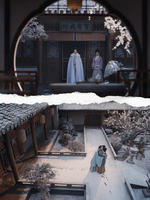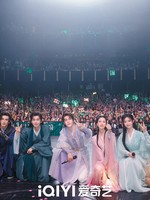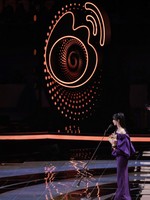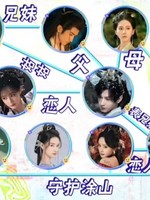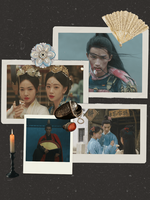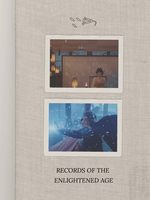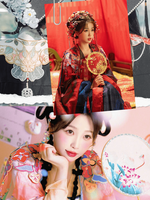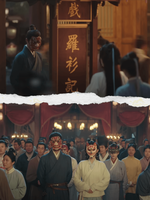“We want to faithfully recreate the details of everyday life in the Ming dynasty and present the period’s distinctive aesthetic on multiple levels,” says The Glory's production designer Wang Yifan.
“Fang laoshi (costume designer Fang Sizhe) focuses on grounding the designs in reality — and that’s something I really love,” adds director Yang Long.
'The Glory' is the latest drama featuring costume design by the team at Fang Sizhe Costume Design Guanjin Stylist Studio. Their previous work includes designs for Mysterious Lotus Casebook, Story of Kunning Palace, A Journey to Love, A League of Nobleman, New Life Begins, Immortal Samsara, and The Long Ballad.
From the beautiful costumes by the team led by Fang Sizhe, to the meticulous props under the helm of production designer Wang Yifan, many elements crafted for the drama have been informed by historical records from the Ming dynasty.
Here is a collection of the most striking highlights.
Women’s Clothing
Ming Dynasty Ladies’ Attire
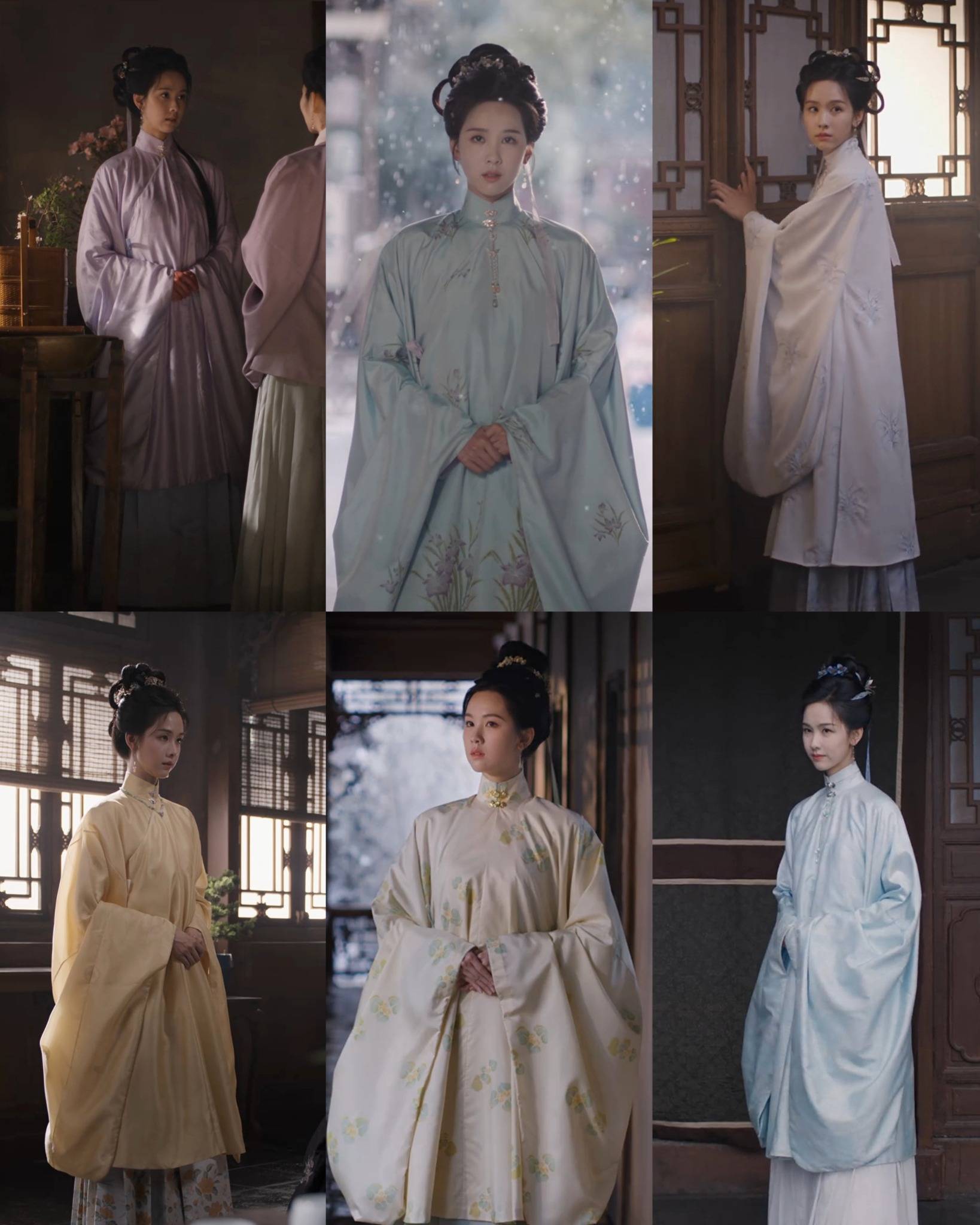
The drama’s representation of ladies’ clothing in the Ming dynasty stands out in particular.
Zhuang Hanyan (Chen Duling) wears elegant Ming-style ensembles, pairing a long top, known as changshan (长衫 chángshān) or chang’ao (长袄 cháng’ǎo), with a long skirt, usually the mamianqun (马面裙 mǎmiànqún), which means ‘horse-face skirt’.
Collars
Ming dynasty upper garments feature a range of collar styles, including the era’s standing collar (立领 lìlǐng, also called 竖领 shùlǐng) with zimu kou (子母扣 zǐmǔ kòu) metal clasp buttons, the round collar (圆领 yuánlǐng), the parallel collar (直领 zhílǐng), the square collar (方领 fānglǐng), and the quintessential crossed collar, known as jiaoling youren (交领右衽 jiāolǐng yòurèn) when it crosses from left to right to form a Y-shaped neckline.
Front panels (襟 jīn) connected to the collar typically come in two styles: the dajin (大襟 dàjīn, also called 斜襟 xiéjīn), a diagonal panel that usually closes to the right, and the duijin (对襟 duìjīn), a parallel panel that runs straight down the front.
Pendants known as zhuiling (坠领 zhuìlǐng) embellish Hanyan’s collars, a detail also seen in the drama Blossom.
Tops
There are two main types of Ming upper garments: shan (衫 shān), a single-layered shirt-like garment, and ao (袄 ǎo), a lined jacket-like garment. Shan could be tucked into the skirt, while ao would always be untucked.
Longer styles, known as changshan (长衫 chángshān) or chang’ao (长袄 cháng’ǎo), with chang meaning ‘long’, gained popularity during the later Ming period.
Skirts
The Ming dynasty’s distinctive qun (裙 qún) is the mamianqun (马面裙 mǎmiànqún), meaning ‘horse-face skirt’. It consists of four panels: two outer and two inner, arranged at the front and back in overlapping pairs sewn together on a waistband with ties. There is a flat panel at the front and back of the skirt, as well as pleated sections on both sides.
Evolving from the xuanqun (旋裙 xuánqún), meaning ‘whirling skirt,’ of the Song dynasty, the mamianqun became widely worn across social classes during the Ming dynasty. The skirt’s hem and knee are often adorned with wide decorative borders. Variations in the material, color, and details of these embellishments reflect social rank.
The OOTD
Together, ao or shan paired with qun forms the classic Ming dynasty outfit known as aoqun (袄裙 ǎoqún).
Ladies can layer this aoqun ensemble with outer garments like the pifeng (披风 pīfēng) robe or doupeng (斗篷 dǒupéng) cloak. They would also wear trousers and various undergarments underneath the aoqun.
Yunjian Tongxiu: Cloud Collar and Sleeves
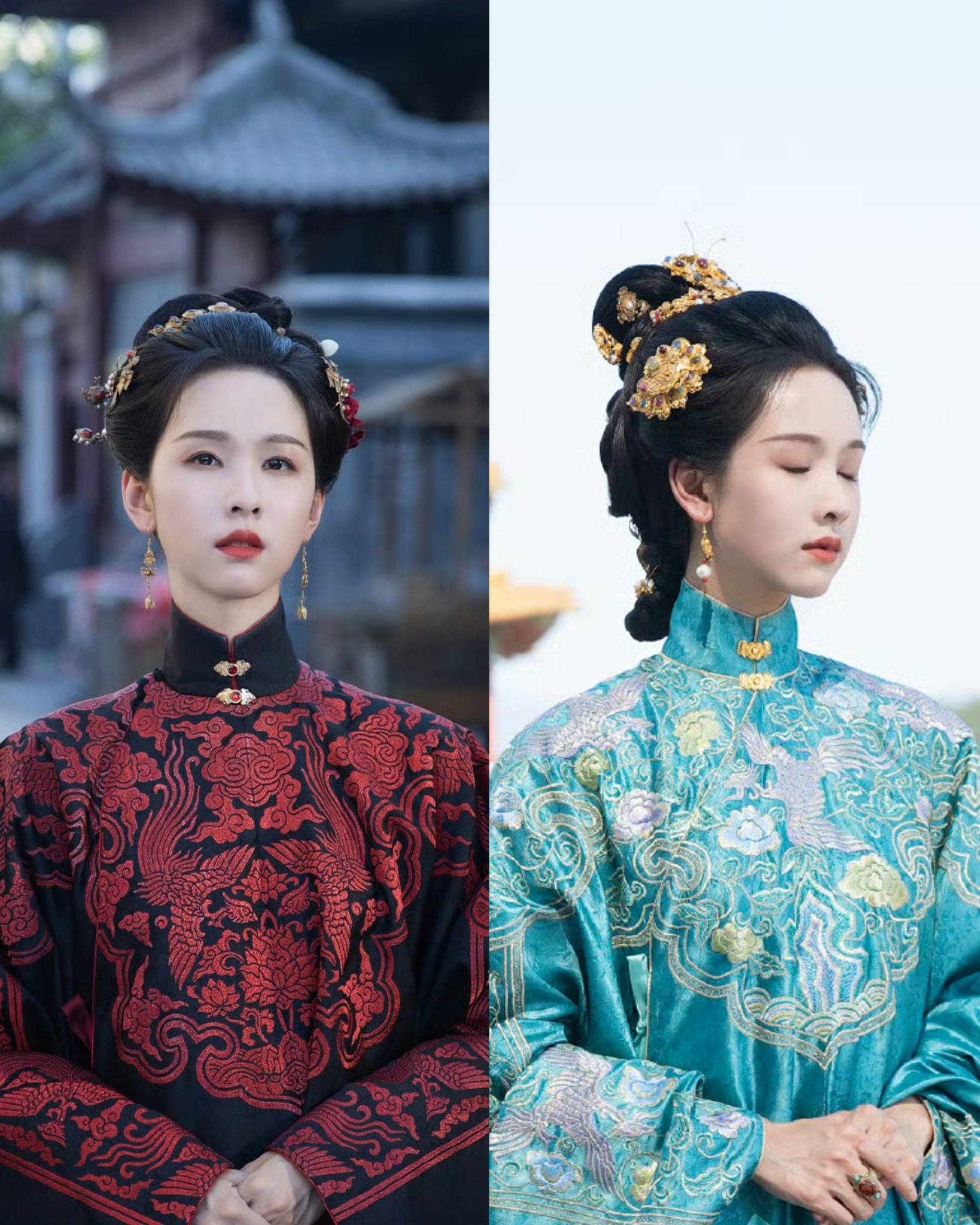
Zhuang Hanyan is seen in two key outfits featuring yunjian tongxiu (云肩通袖 yúnjiān tōngxiù), an ornamental design commonly found on Ming dynasty ceremonial and formal attire.
Yunjian (云肩 yúnjiān), or ‘cloud collar,’ refers to the lobed motif across the chest, shoulders, and upper back. Tongxiu (通袖 tōngxiù) describes the continuous pattern that runs through the wide, flowing sleeves.
Originally a decorative pattern on garments, the yunjian ‘cloud collar,’ as seen in these yunjian tongxiu, traces its roots to earlier dynasties.
By the late Ming period and into the Qing dynasty, it evolved into a detachable garment accessory. We can spot the iconic detachable cloud collar in recent dramas like ‘Love Game in Eastern Fantasy,’ as well as in Qing dynasty palace dramas.
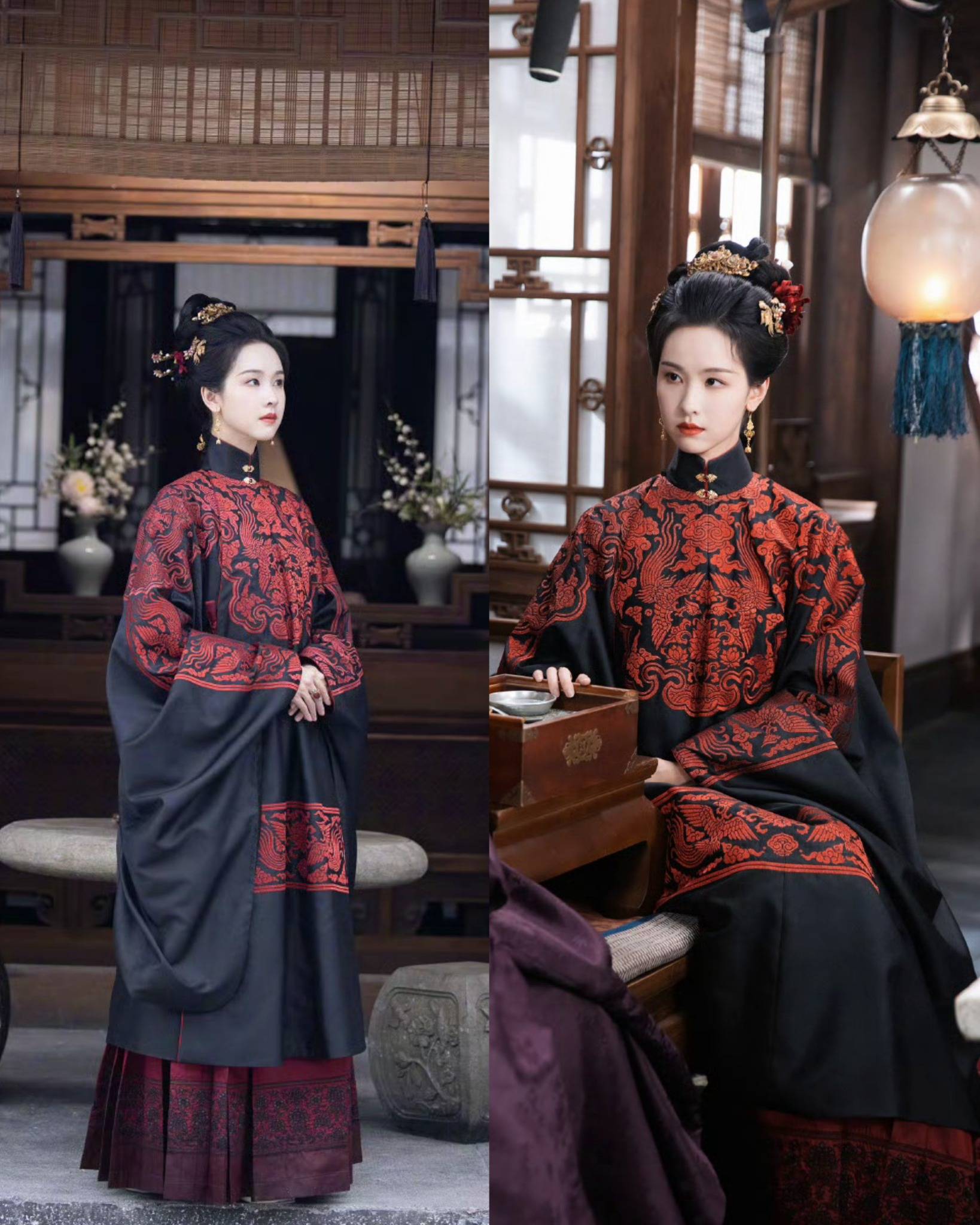
Hanyan’s black-and-red ensemble features a classic yunjian tongxiu design woven with phoenixes and peonies, an auspicious pairing known as feng chuan mudan (凤穿牡丹 fèng chuān mǔdān), meaning ‘phoenix flying through peonies.’
The mythical fenghuang (凤凰 fènghuáng), often translated as ‘phoenix’, is revered in Chinese culture as the king of birds and a symbol of the empress. Meanwhile, the peony is known as the king of flowers, representing wealth, good fortune, and happiness.
This ‘phoenix flying through peonies’ motif was treasured during the Ming and Qing dynasties, frequently appearing in embroidery and on porcelain.
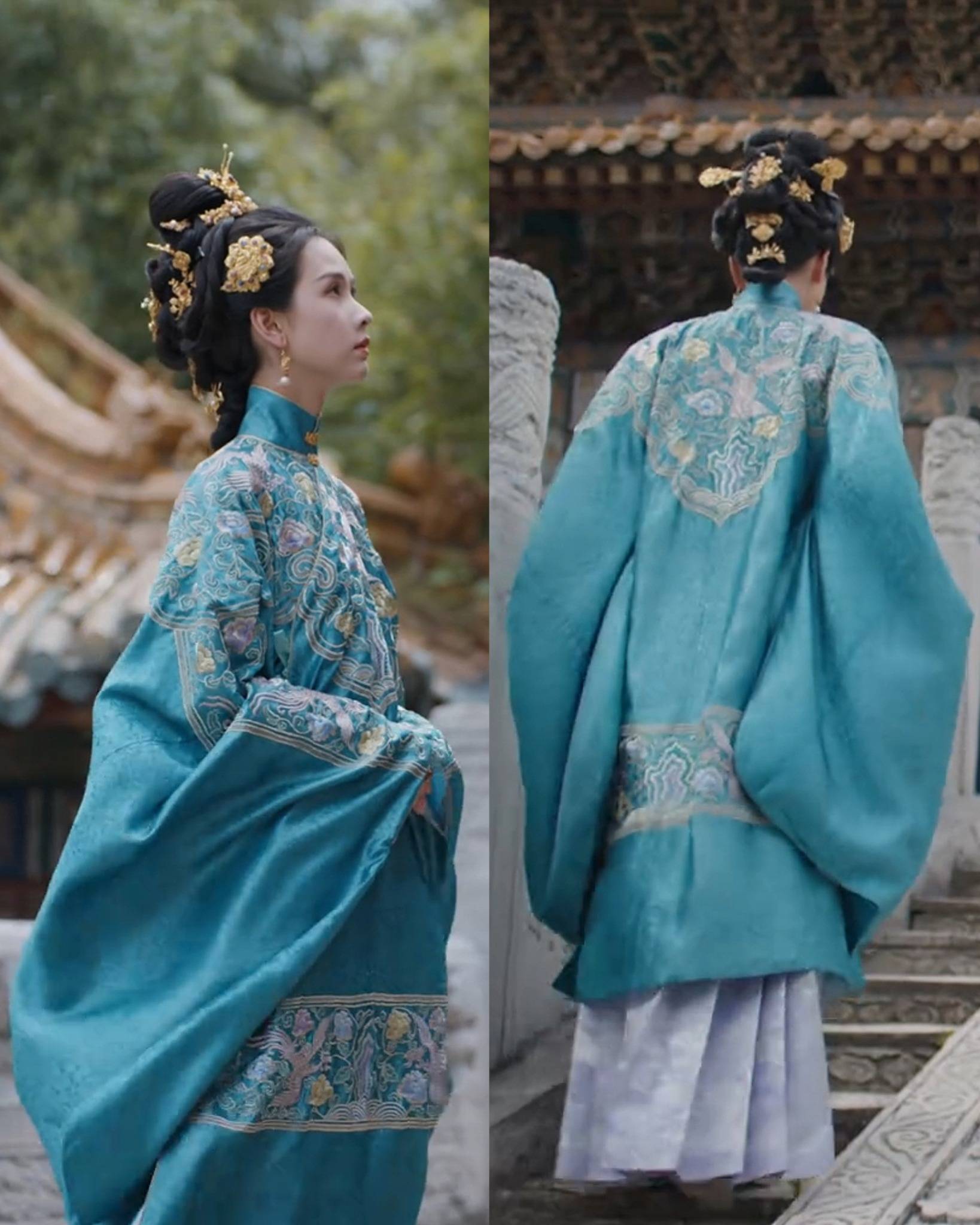
In her kingfisher blue outfit, lotus and phoenix motifs are incorporated into the yunjian tongxiu design. The lotus, a prominent symbol in Ming dynasty blue-and-white porcelain, represents purity, resilience, and the ability to rise unsullied from the mud. Paired with the fenghuang, the resulting design exudes a sense of presence and elegance.
These outfits make fabulous power looks for Hanyan’s palace visit to Noble Consort Miao (Li Sheng) and her journey to seek justice with strength, virtue, and poised resolve.
Grape Motifs
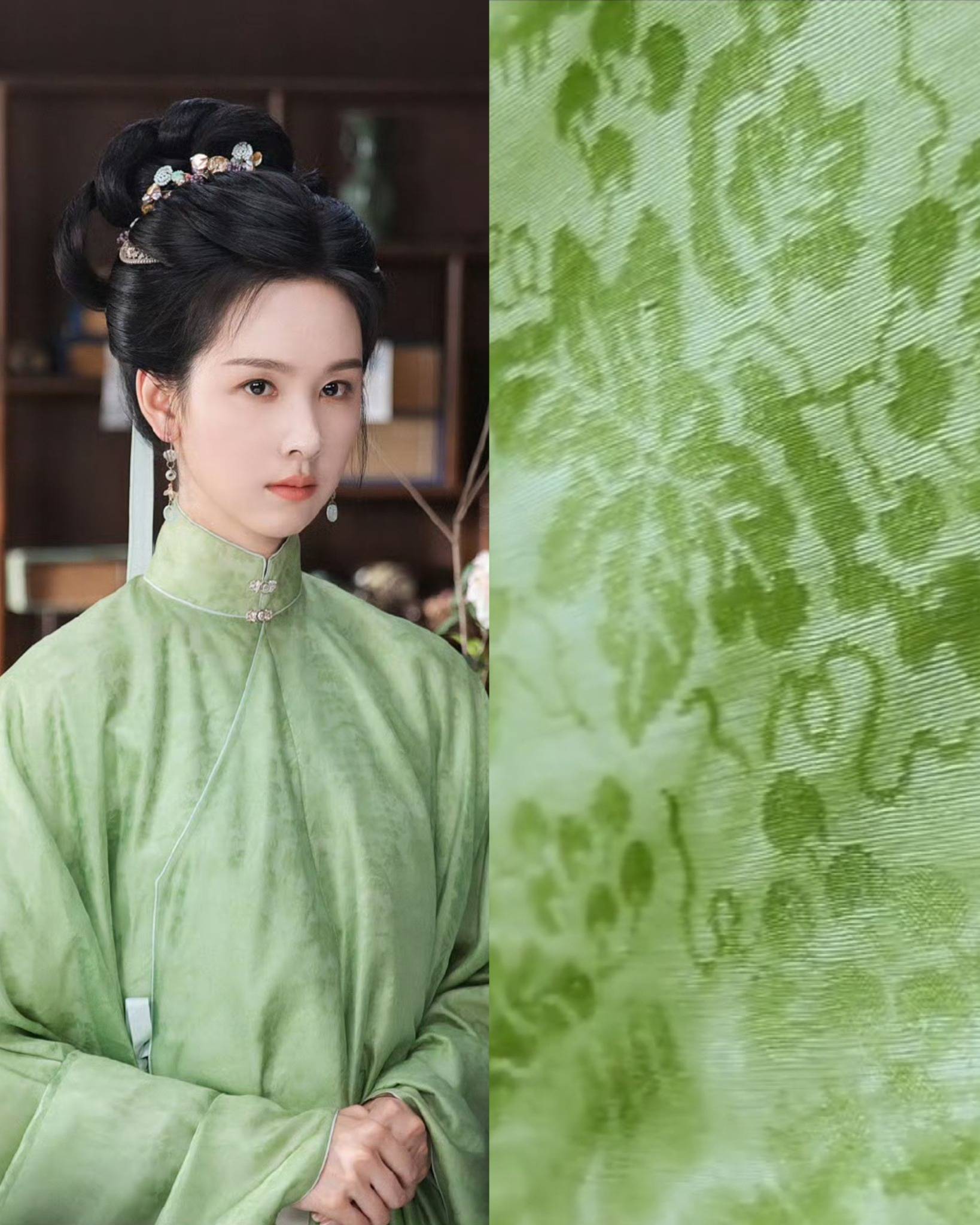
In her light green ensemble, Zhuang Hanyan wears a liling dajin shan, which translates to a diagonal-panel upper garment with a standing collar. When we take a closer look, we can see subtle grape motifs woven into this silk garment.
The grape patterns on her garment shimmer in and out of view under shifting light, symbolizing Hanyan’s inner growth and transformation as she comes into her own and uncovers long-buried family secrets.
This motif draws inspiration from the Mahin Banu ‘grape’ dish, a piece of blue-and-white porcelain made at the imperial kilns of Jingdezhen during the Yongle reign of the Ming dynasty. The dish once belonged to the Persian princess Mahin Banu Khanum — an influential advisor, diplomat, philanthropist, and collector — reflecting the exchange of ideas and creative influence between Chinese and Persian cultures.
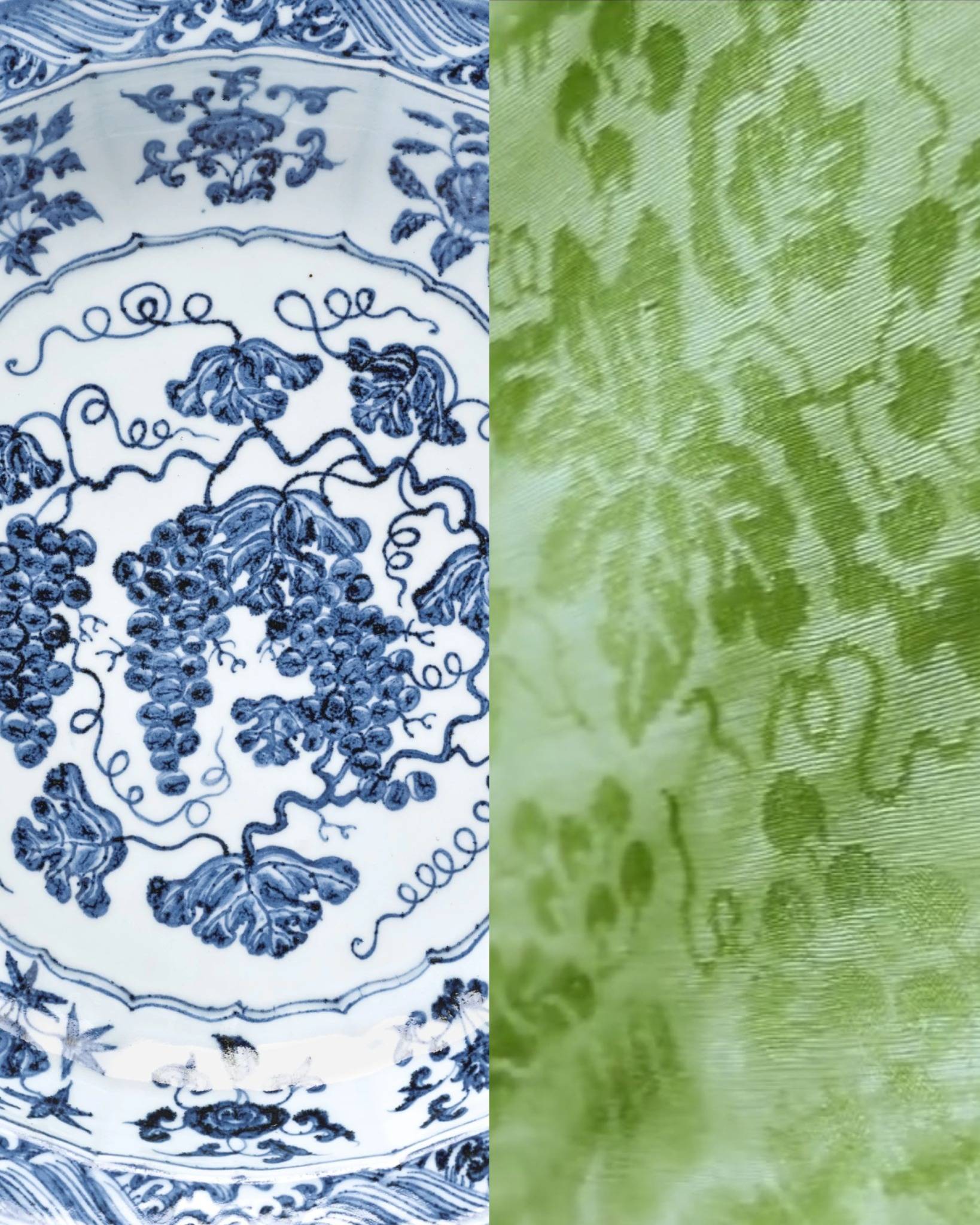
Grape motifs were popular during the Ming dynasty. They can often be spotted on blue-and-white porcelain, sometimes paired with squirrels to symbolize abundance, prosperity, and longevity.
Morning Glory Motifs
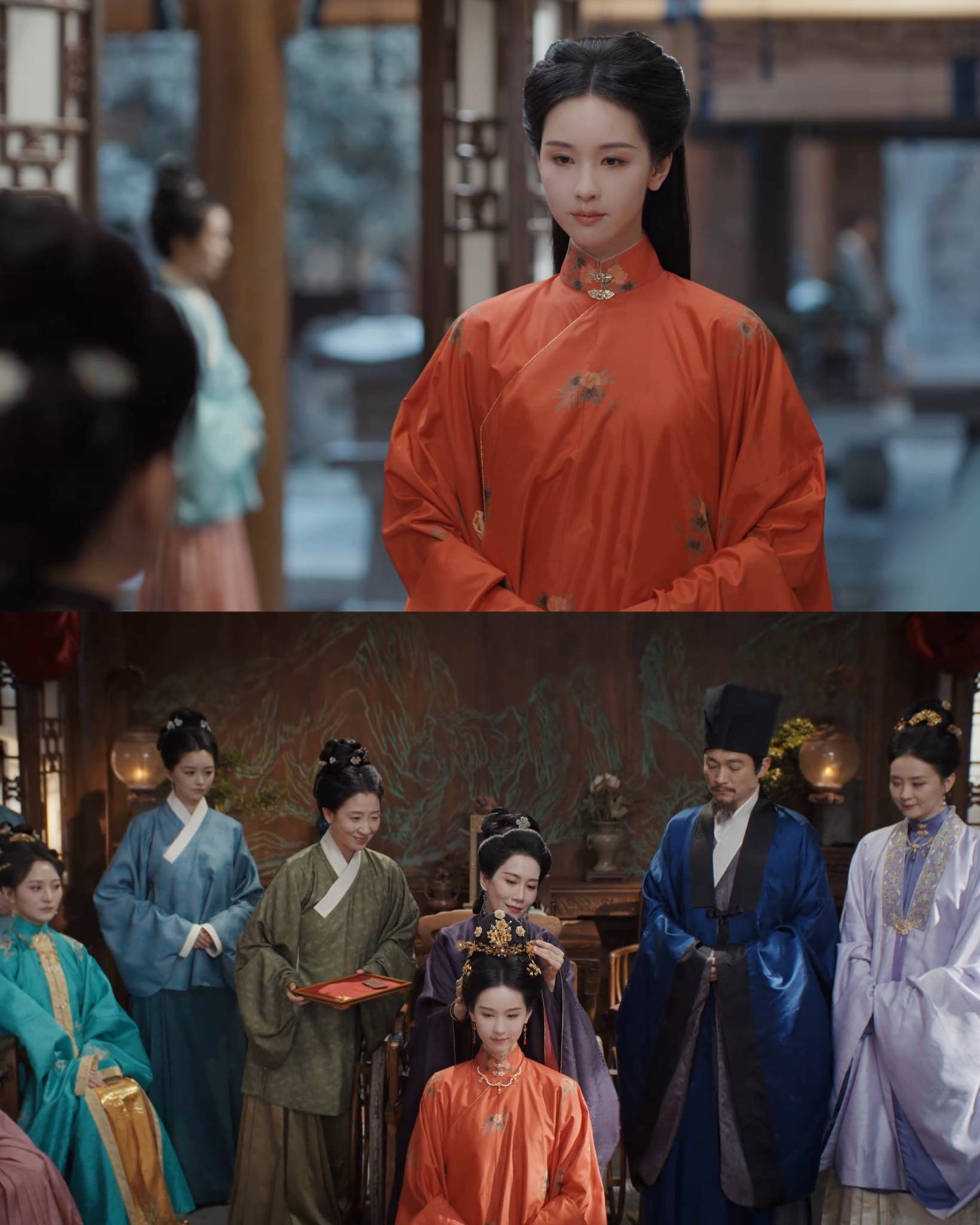
Zhuang Hanyan wears an ensemble decorated with morning glory flowers during her ji li (笄礼 jī lǐ), the traditional coming-of-age hairpin ceremony for young women in Chinese culture. This distinctive floral pattern blooms throughout her liling dajin shan upper garment and the pifeng outer robe she dons upon completing the ritual.
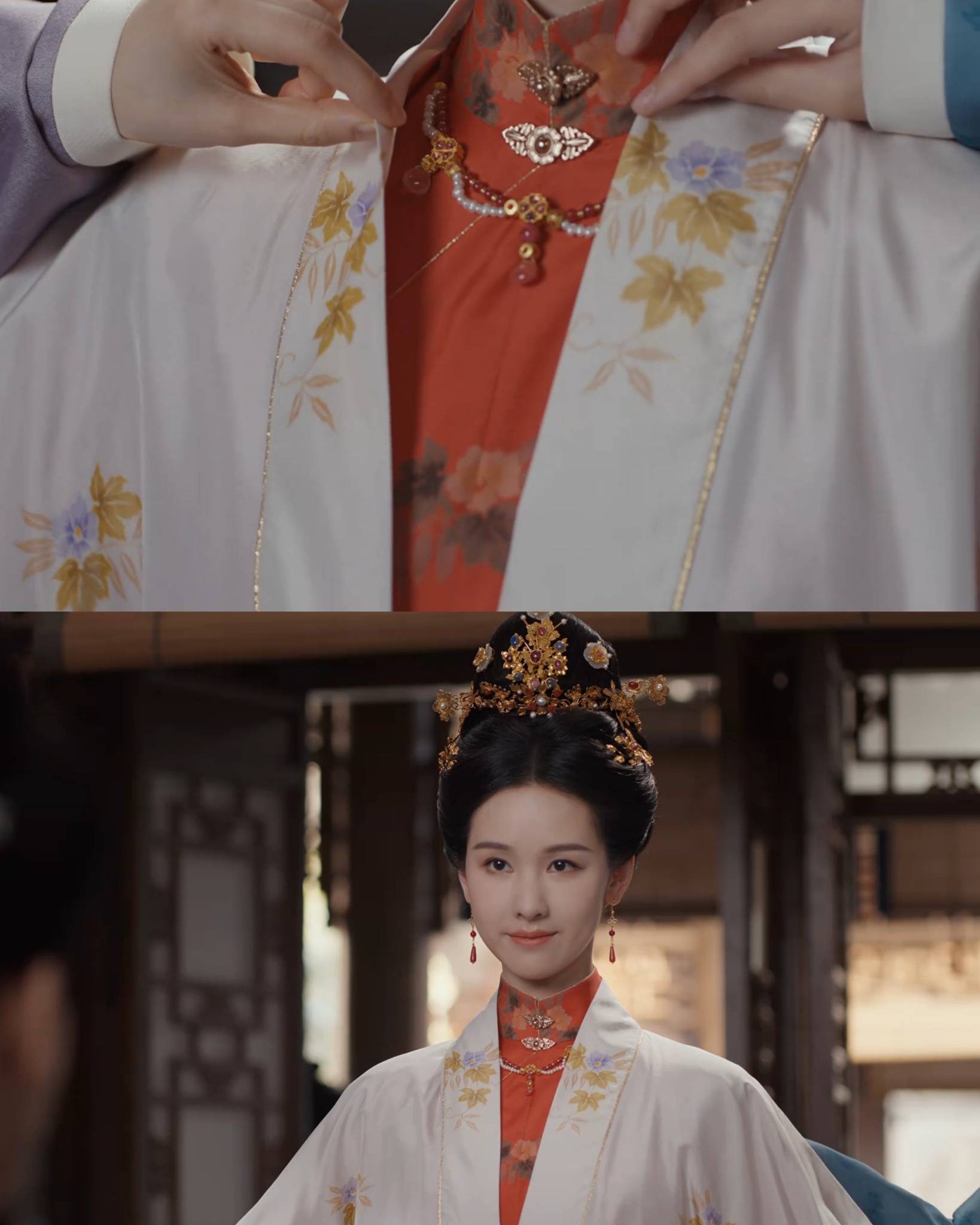
The morning glory flower is another notable motif on silk textiles and porcelain wares from the Ming and Qing dynasties. It symbolizes resilience, love, and affection, effectively highlighting Hanyan’s inner strength and unyielding spirit, backed by her mother’s love, as she officially steps into adulthood.
Meizi: Decorative Trims
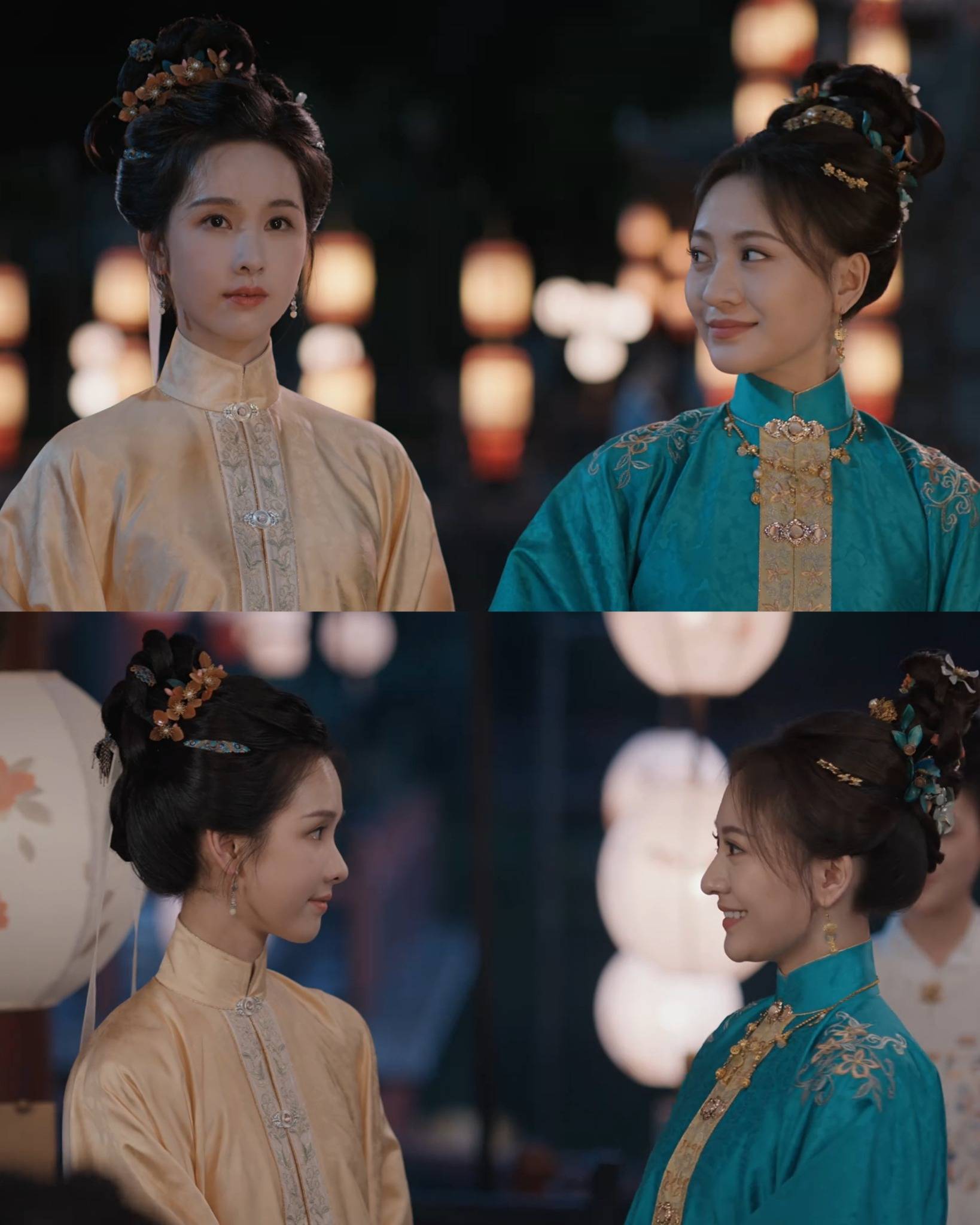
Decorative trims running vertically down the front of garments worn by Zhuang Hanyan and Li Jiaqi (Zeng Ziye) are beautiful examples of meizi (眉子 méizi), a type of adornment that gained popularity in the late Ming period.
Ming dynasty meizi are often crafted from brocade and display prominent or subtly woven floral patterns.
True to the era, the meizi on each lady's liling duijin shan, meaning parallel front panel upper garment with a standing collar, features soft floral motifs embellished with gold and silver thread, flowing gracefully down from the collar.
Women's Hair and Accessories
Yanwei: Swallowtail Hairstyle
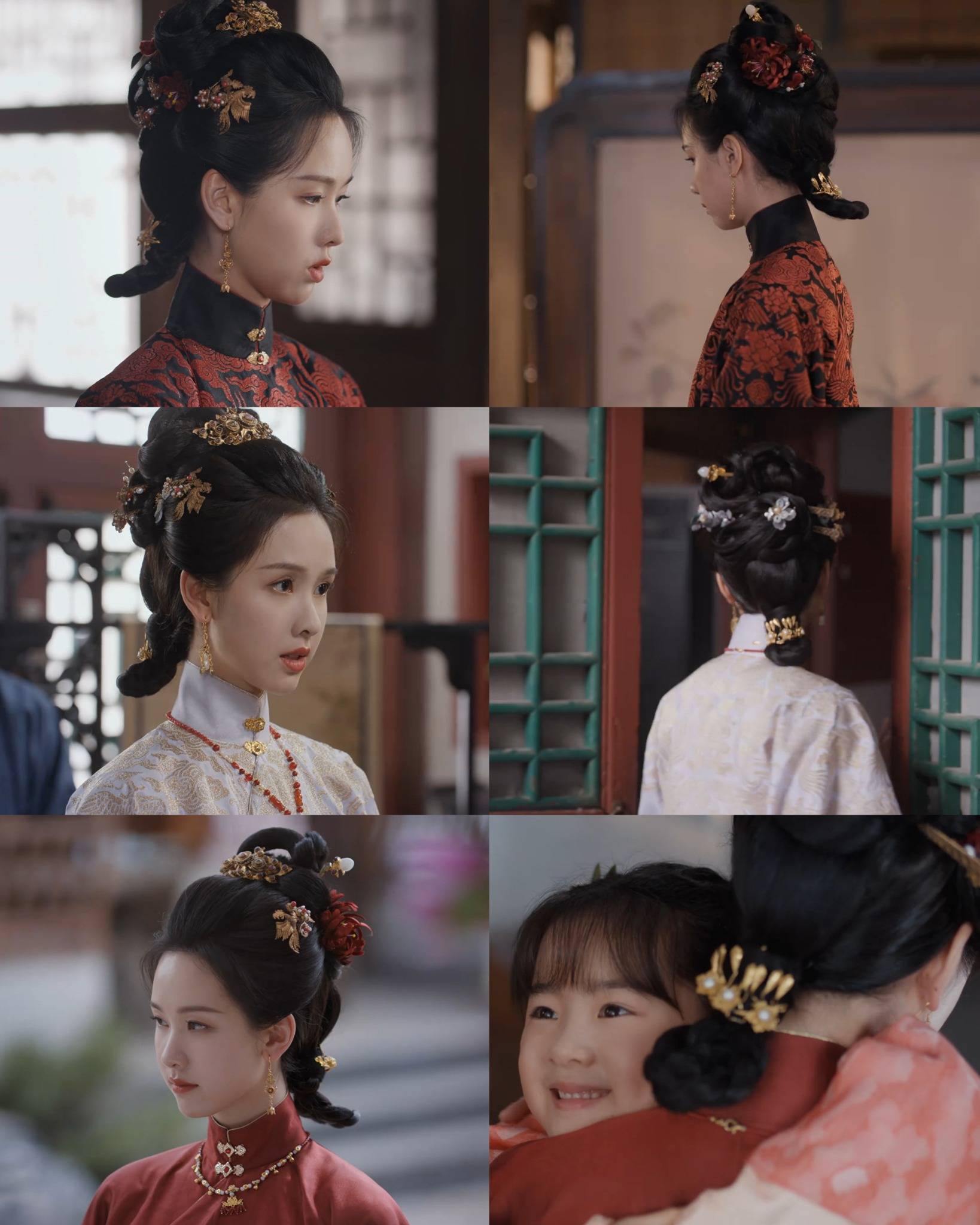
After her wedding, Zhuang Hanyan gathers part of her hair into a distinctive low bun called yanwei (燕尾 yànwěi), which means ‘swallowtail.’
Although often associated with women’s hairstyles of the Manchu Qing dynasty, the yanwei originated in the Ming dynasty and was only subsequently adopted by women in the late Qing period.
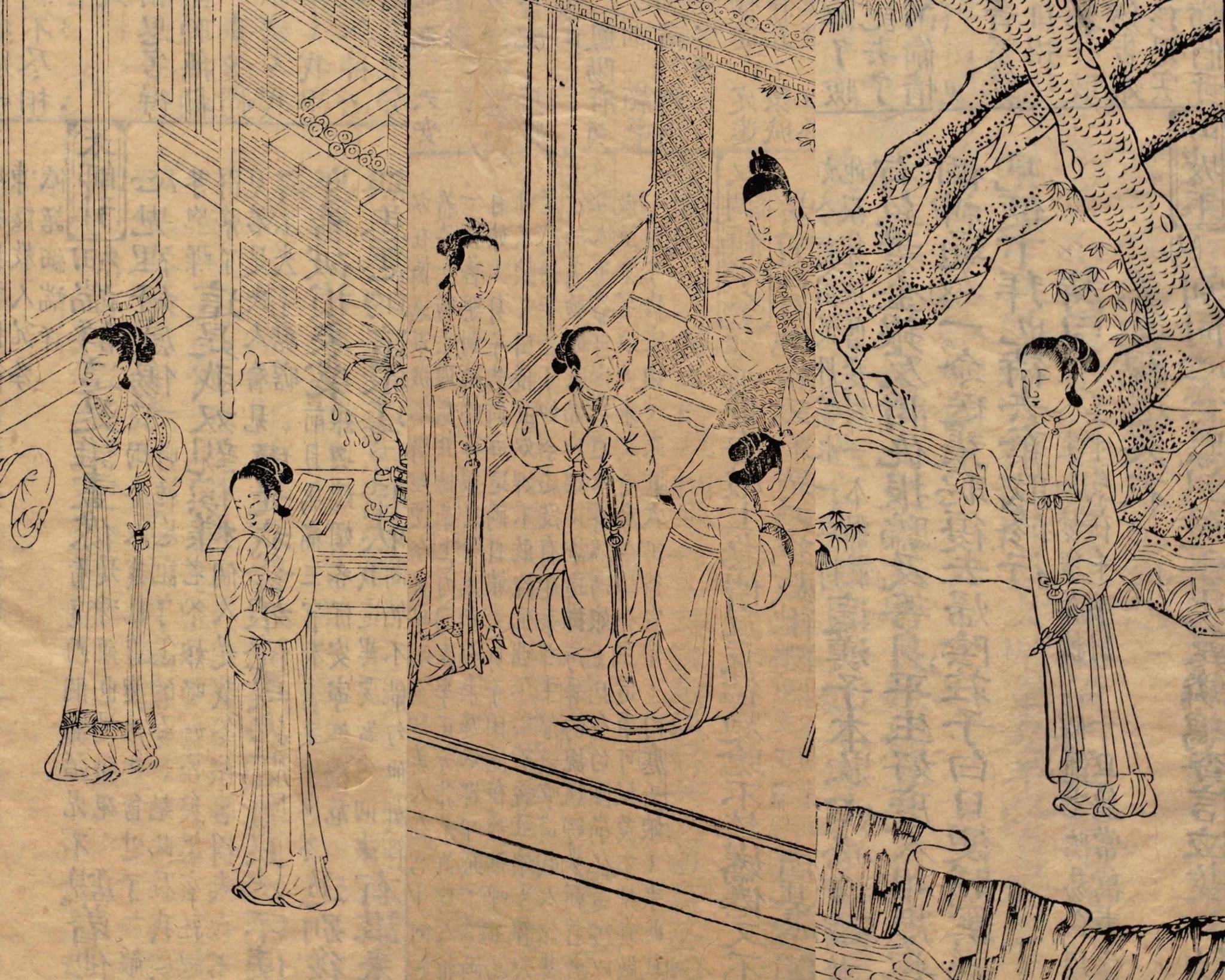
Hair is combed into a flat bun at the nape of the neck and often styled with the help of a hairpiece into a shape resembling the tail of a swallow when viewed from a distance — hence the name yanwei, or ‘swallowtail’ hairstyle.
This birdlike detail suits Hanyan wonderfully. The yàn in her name Hanyan means wild goose, while yàn in yanwei (‘swallowtail’) refers to the swallow bird. Sharing a pronunciation, both are migratory birds rich in symbolism in Chinese culture, encapsulating Hanyan’s growth as she spreads her wings and flies back home in search of truth and belonging.
Yanbin: 'Temple Cover' Hairpins
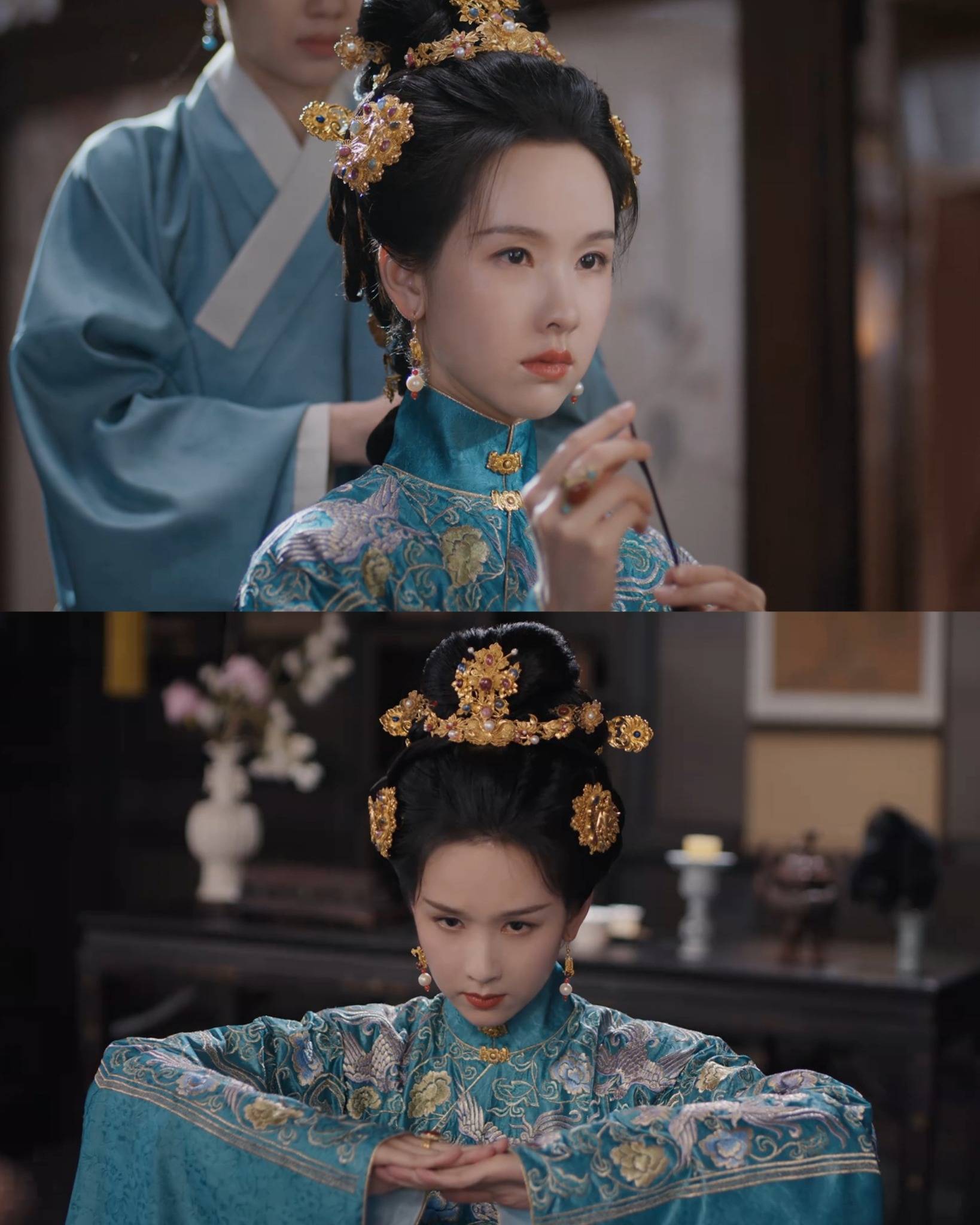
Zhuang Hanyan wears hairpins known as yanbin (掩鬓 yǎnbìn), meaning ‘temple covers,’ in mirrored pairs to frame the temples at the front of the head.
A signature look in the Ming and Qing dynasties, a pair of yanbin would be inserted in an inverted position from bottom to top, securing hair symmetrically on both sides of the head.
Crafted from fine filigree and shaped into blossoms and leaves, yanbin often resemble cloud-like floral clusters inspired by Buddhist motifs, such as bodhisattvas on auspicious clouds.
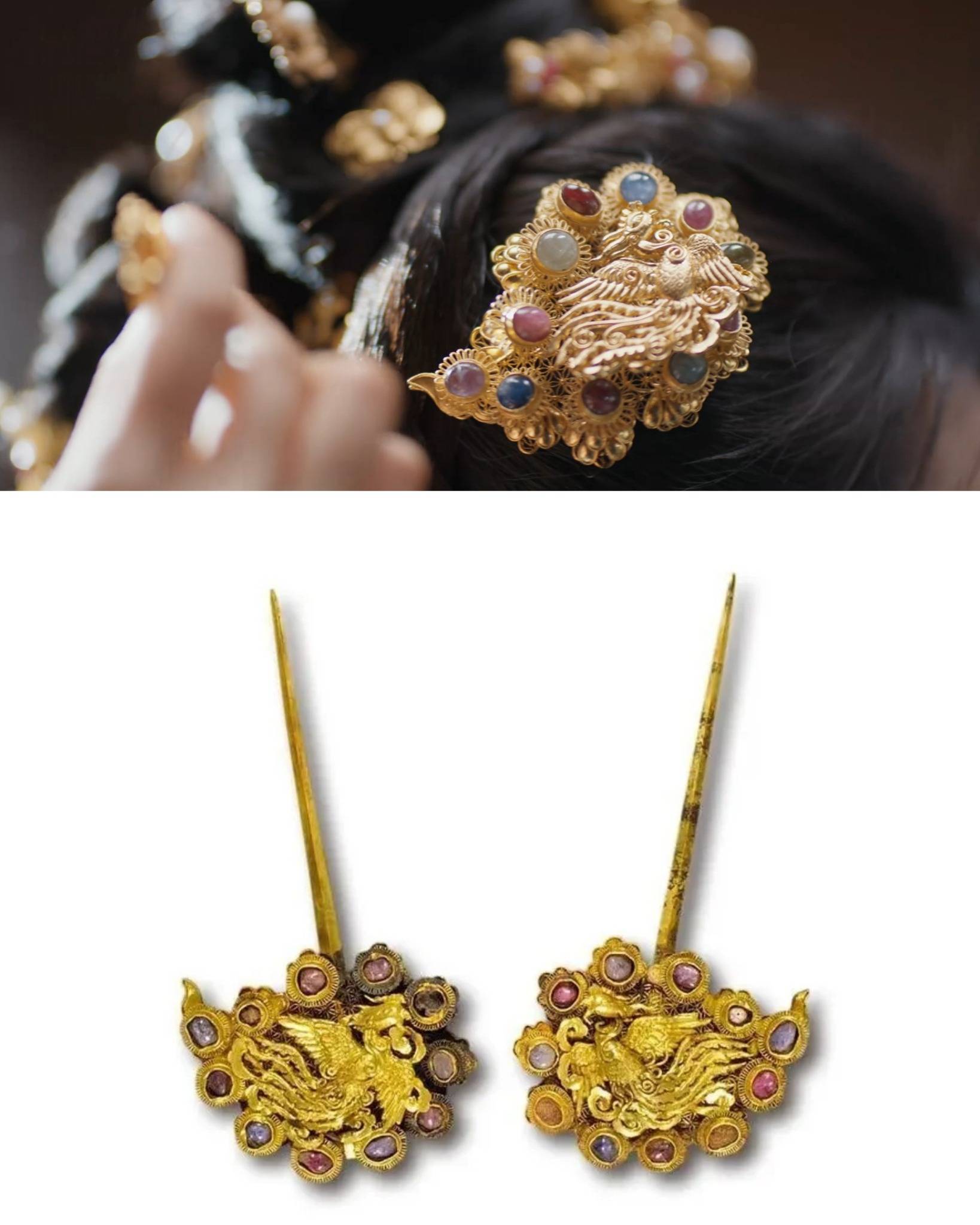
The pair of gemstone-inlaid, gold filigree yanbin worn by Hanyan are modeled after real historical artifacts unearthed from Ming imperial tombs, notably those belonging to Consort Sun, wife of Zhu Yiyin, Prince Xuan of Yi, paying tribute to the extraordinary craftsmanship of the era.
Tiaopai: Ceremonial Hairpins
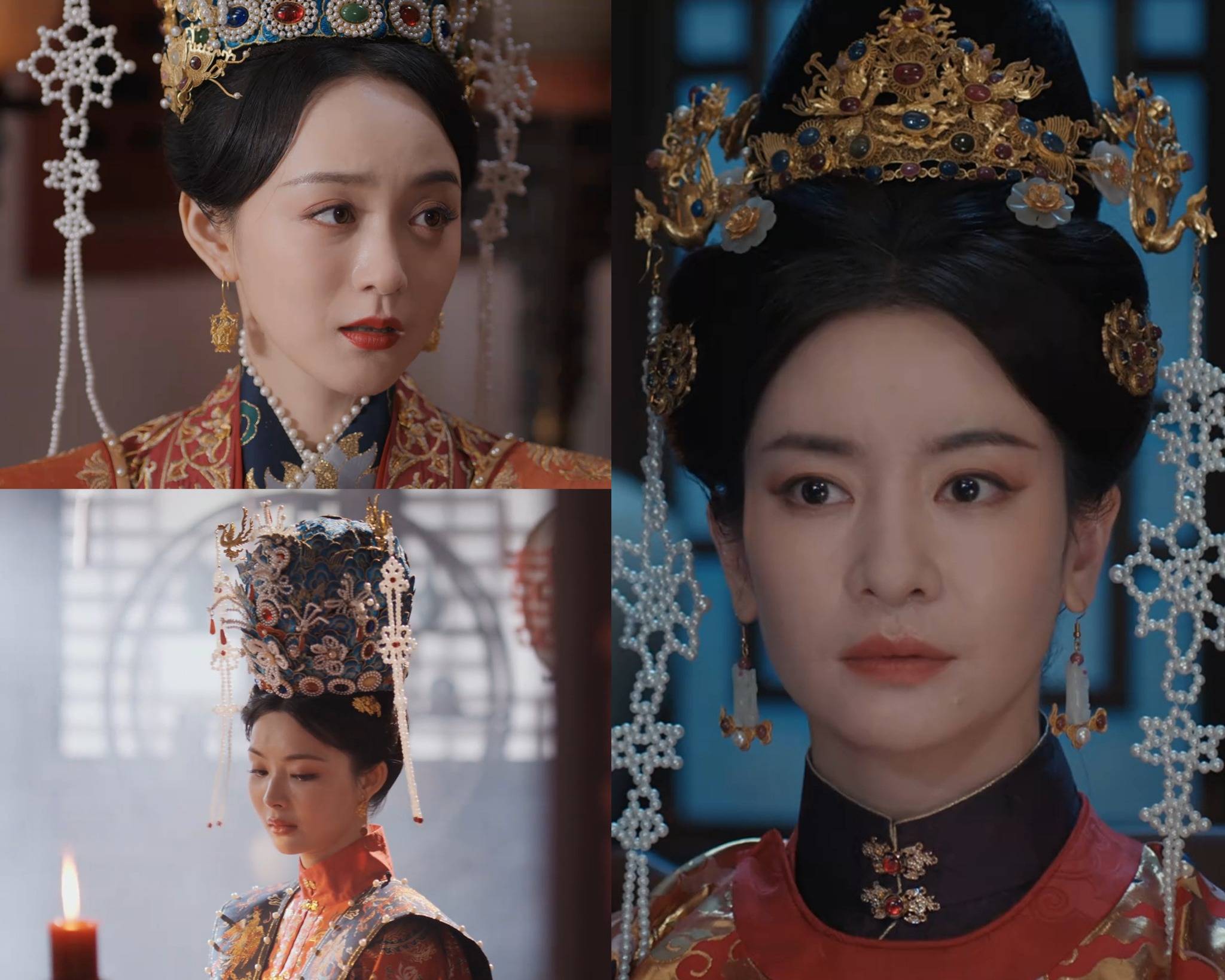
Noble Consort Miao (Li Sheng), Zhuang Yushan (He Hongshan), and Deng Chan (Liao Huijia) wear tassel hairpins, known as tiaopai (挑牌 tiāopái), which were traditionally part of the ceremonial attire of empresses and consorts in the Ming dynasty. Significantly, Zhuang Yushan and Deng Chan wear these hairpins with their fengguan xiapei (凤冠霞帔 fèngguān xiápèi) wedding ceremony attire.
The tiaopai consists of a pair of gold hairpins — often shaped like phoenix heads, dragon heads, or lotus blossoms — with long, dangling tassels streaming down from each one. As seen on the ladies’ headwear, the tassels are usually crafted from strands of pearls in openwork designs. Sometimes, they are accented with gemstone inlay.
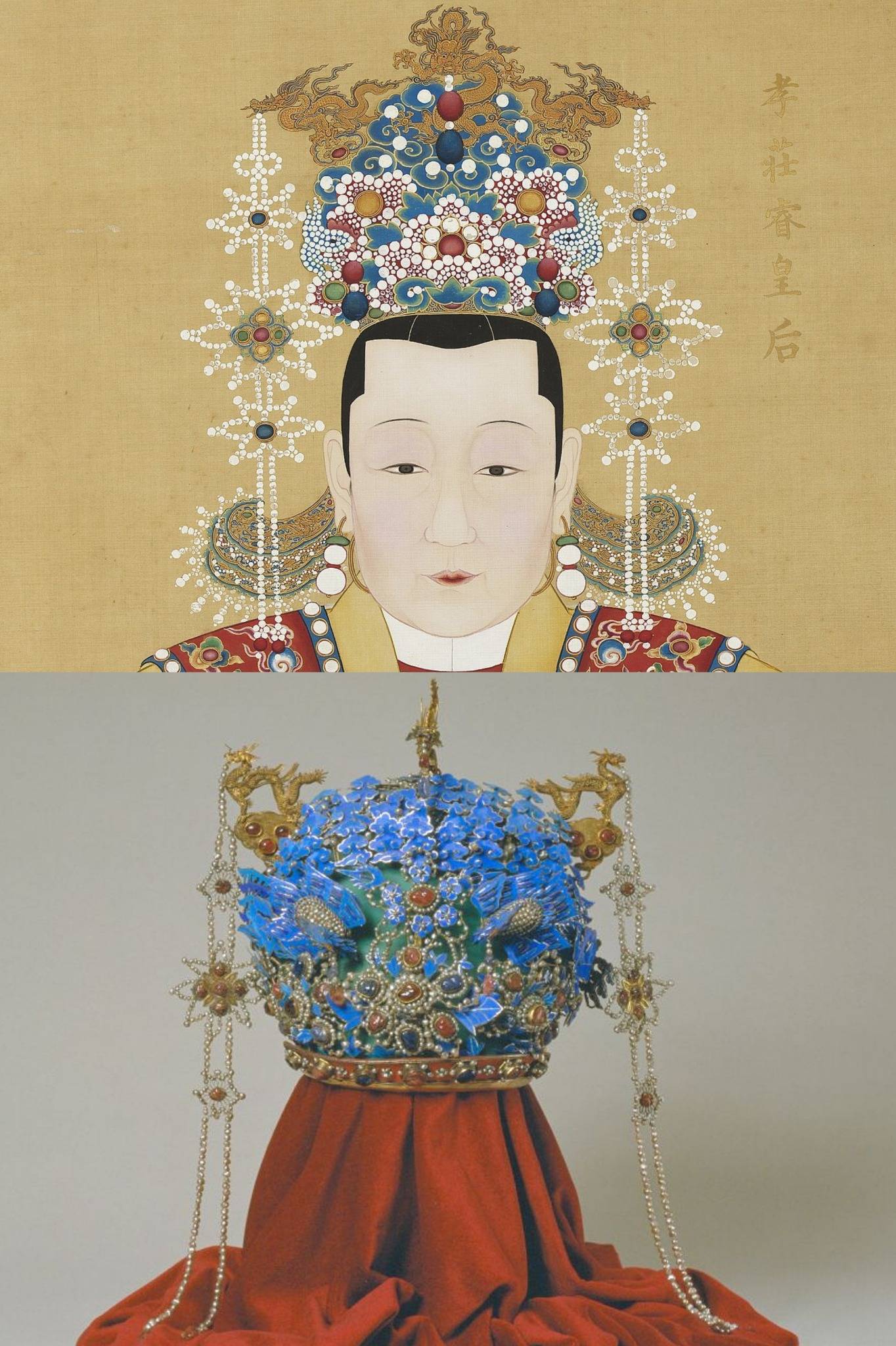
The name tiaopai comes from the way its long beaded tassels hang ‘lifted high’ atop the head, embellishing ceremonial crowns, such as the fengguan, aka ’phoenix crown,’ on Zhuang Yushan and Deng Chan, or the bun-style headpiece known as the diji, on Noble Consort Miao.
Men’s Clothing
Buzi: Rank Badges on Official Robes
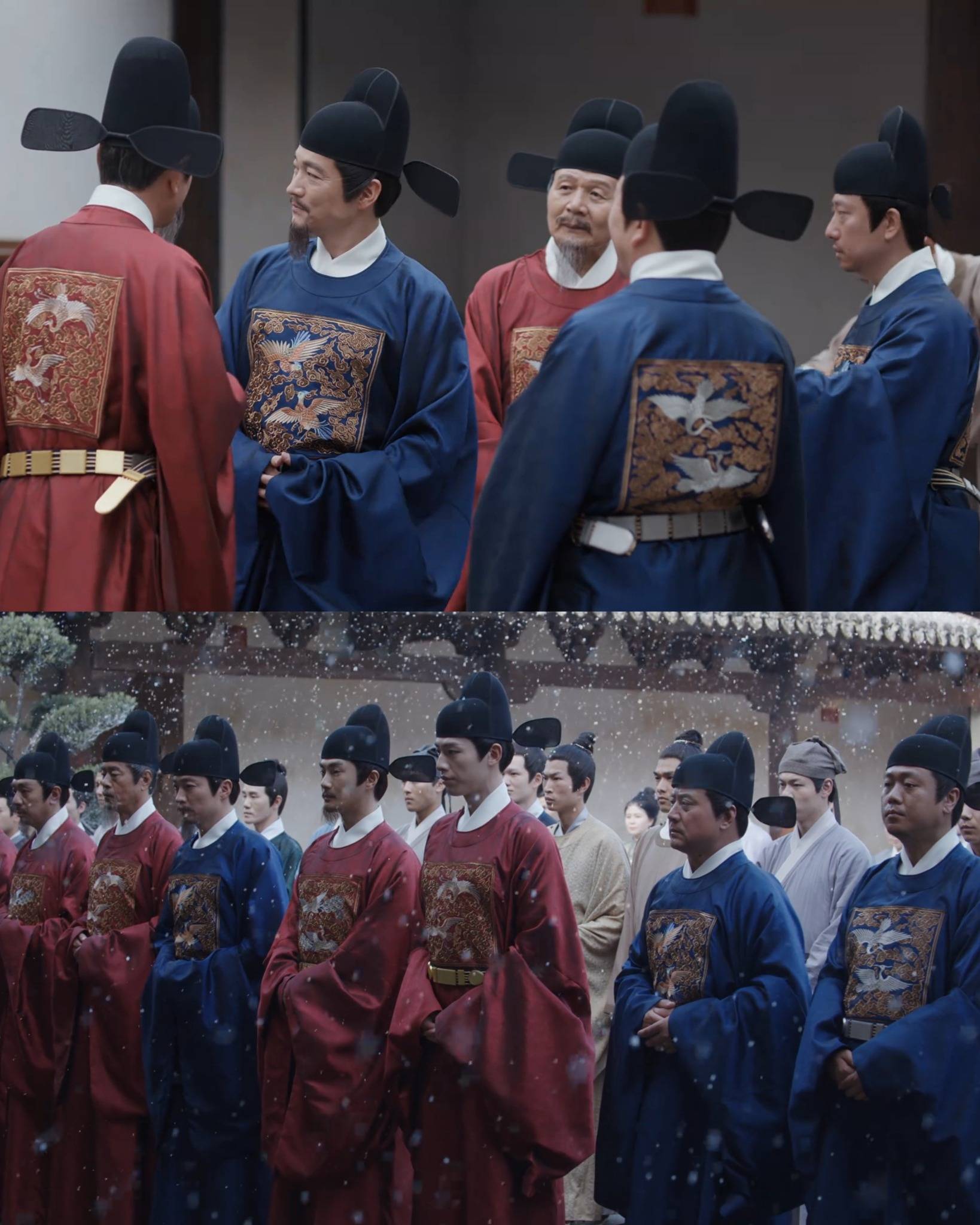
Fu Yunxi (Xin Yunlai), Zhuang Hanyan’s father, Zhuang Shiyang (Yu Entai), and other officials often wear wusha mao (乌纱帽 wūshā mào) headwear and official robes with square embroidered pieces on the front and back. These pieces are known as buzi (补子 bǔzi), an ornamental rank badge used to signify an official’s status and position within the court during the Ming and Qing dynasties. The imperial court strictly regulated buzi designs, which could not be produced freely or in large quantities.
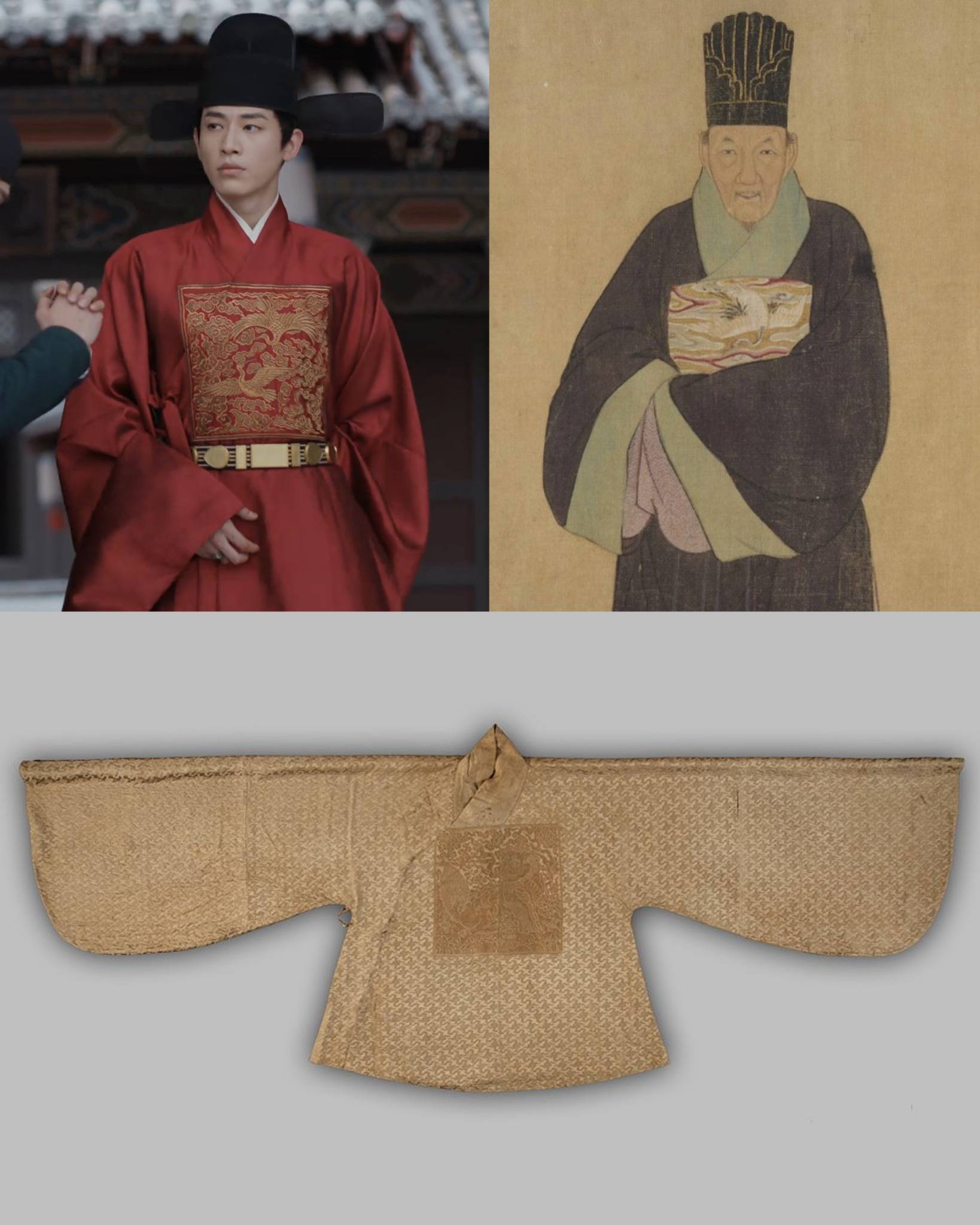
We sometimes see Fu Yunxi wearing a jiaoling (cross-collared) robe adorned with buzi. While it is less commonly depicted onscreen than the yuanling pao (round-collared robe) typically worn by officials, this style is historically accurate. Portraits and surviving artifacts from the Ming dynasty confirm that jiaoling official robes with buzi rank badges did indeed exist during this era.
Daopao: Daoist Robes
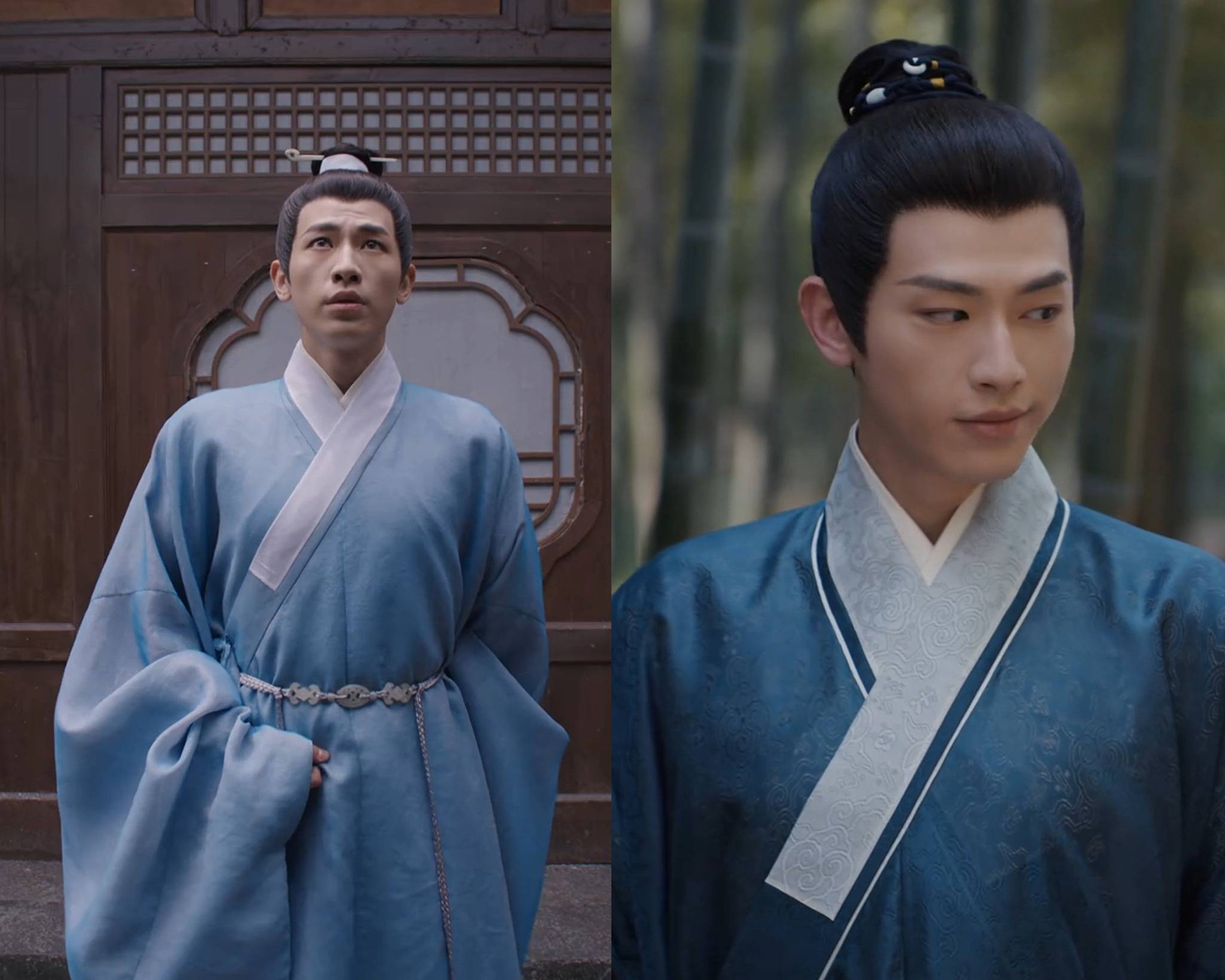
Fu Yunxi wears an assortment of daopao (道袍 dàopáo), which means ‘Daoist robe.’ The daopao was a popular form of everyday attire during the Ming dynasty, widely worn by men, without any necessary connection to Daoism.
This type of robe features a jiaoling youren crossed collar, in accordance with Han Chinese tradition. The collar of the daopao is often edged with a white or plain-colored protective trim called huling (护领 hùlǐng), meaning ‘protective collar.’
The daopao features side slits with hidden inserted panels called anbai (暗摆 ànbǎi), which help conceal undergarments while shaping the robe’s silhouette.
The robe is fastened with fabric ties and typically paired with a silk or cloth sash at the waist. Its sleeves are generally wide, tapering at the wrists.
Dahu: Cropped Sleeve Garments
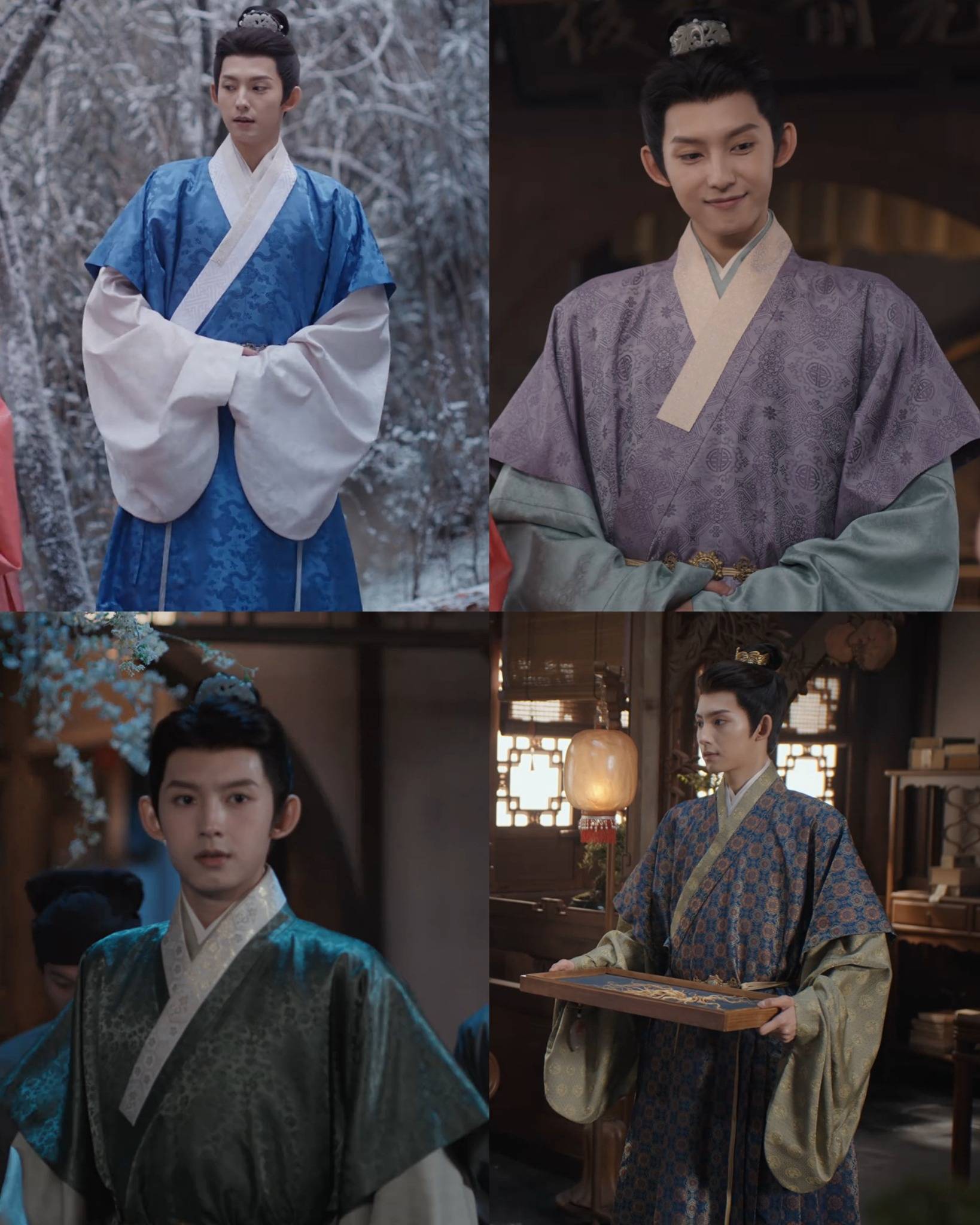
Fourth Young Master Zhuang Yuchi (Liu Xuwei) is often seen throughout the drama wearing a short-sleeved dahu (褡护 dāhù), a type of banbi (半臂 bànbì) garment, meaning ‘half arm,’ which originated in the Sui and Tang dynasties.
The Ming dynasty dahu has a jiaoling youren crossed-collar with a Y-shaped neckline bordered by a huling protective collar, similar to that on the daopao. Either short-sleeved or sleeveless, the dahu is fastened with fabric ties and features slits on both sides, where double-sided panels (摆 bǎi) are inserted, creating a generous silhouette that allows for greater ease of movement.
During the Ming dynasty, the dahu could be worn underneath a round-collared robe or layered over a long-sleeved robe, as seen in Zhuang Yuchi’s signature look in the drama.
Under the reign of the Zhengtong Emperor, the dahu (Chinese: 褡护 dāhù, Korean: 답호 dapho) and the dragon robe (Chinese: 衮龙袍 gǔnlóngpáo, Korean: 곤룡포 gonryongpo) were bestowed upon King Sejong of Joseon, signifying diplomatic ties and the influence of the Ming dynasty on Joseon court style.
Unisex Accessories
Gold-Flecked Folding Fans
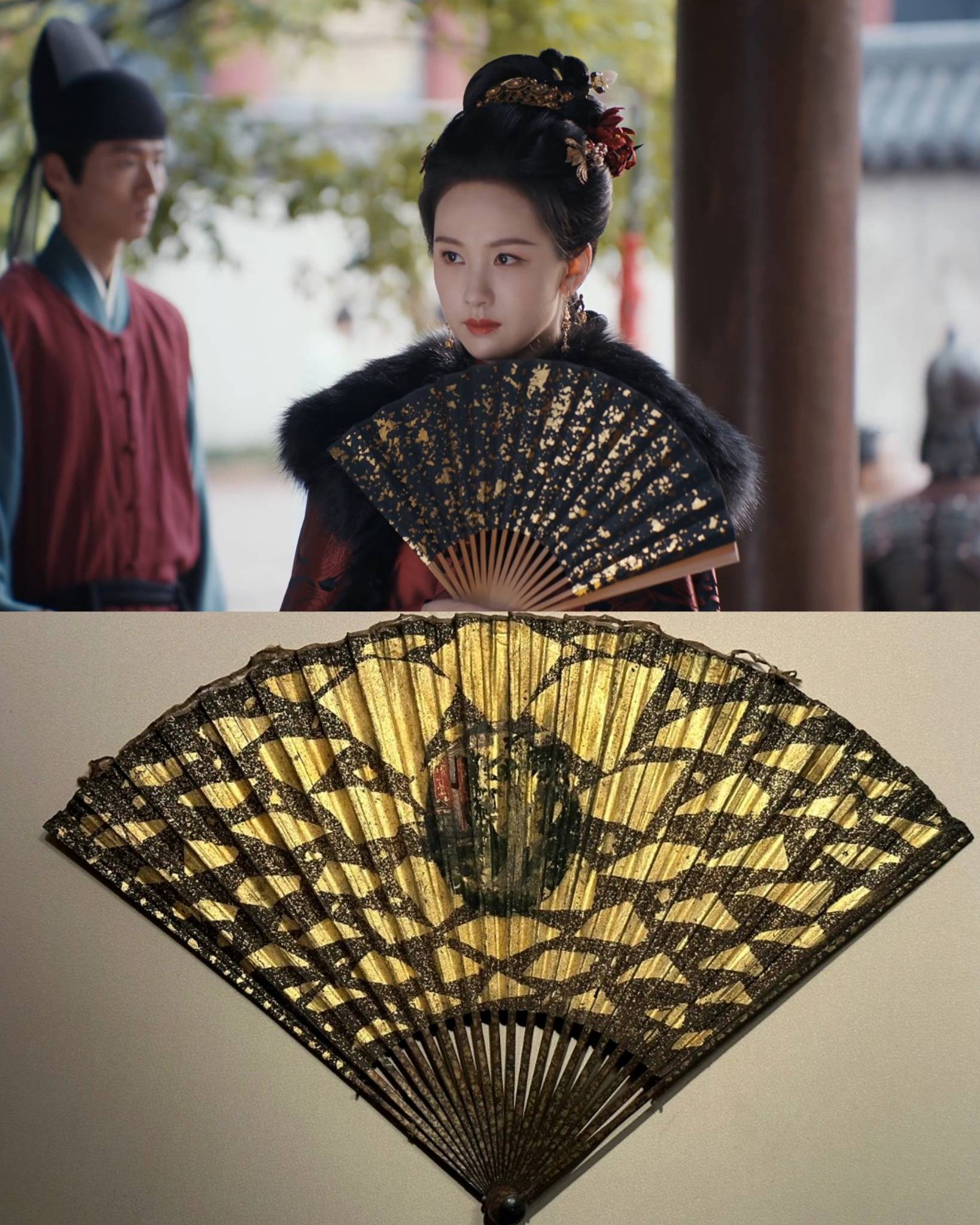
This gold-leaf-flecked folding fan, carried by Zhuang Hanyan, embodies the exquisite artistry of the Ming dynasty. Real gold leaf was mixed with adhesive into a paste and carefully applied to the surface of the paper fan in intricate patterns. These fans required great skill to produce and were very expensive.
You can find Duke Su (Wang Xingyue) wielding an array of gold-flecked paper folding fans in the dark horse hit drama The Double.
In the Ming dynasty, the folding fan was more than a tool for keeping cool. It was known as a vessel for holding emotion and became a canvas to showcase fine art, painting, and calligraphy.
Furniture
Ming-Style Furniture with Distinctive Chair Designs
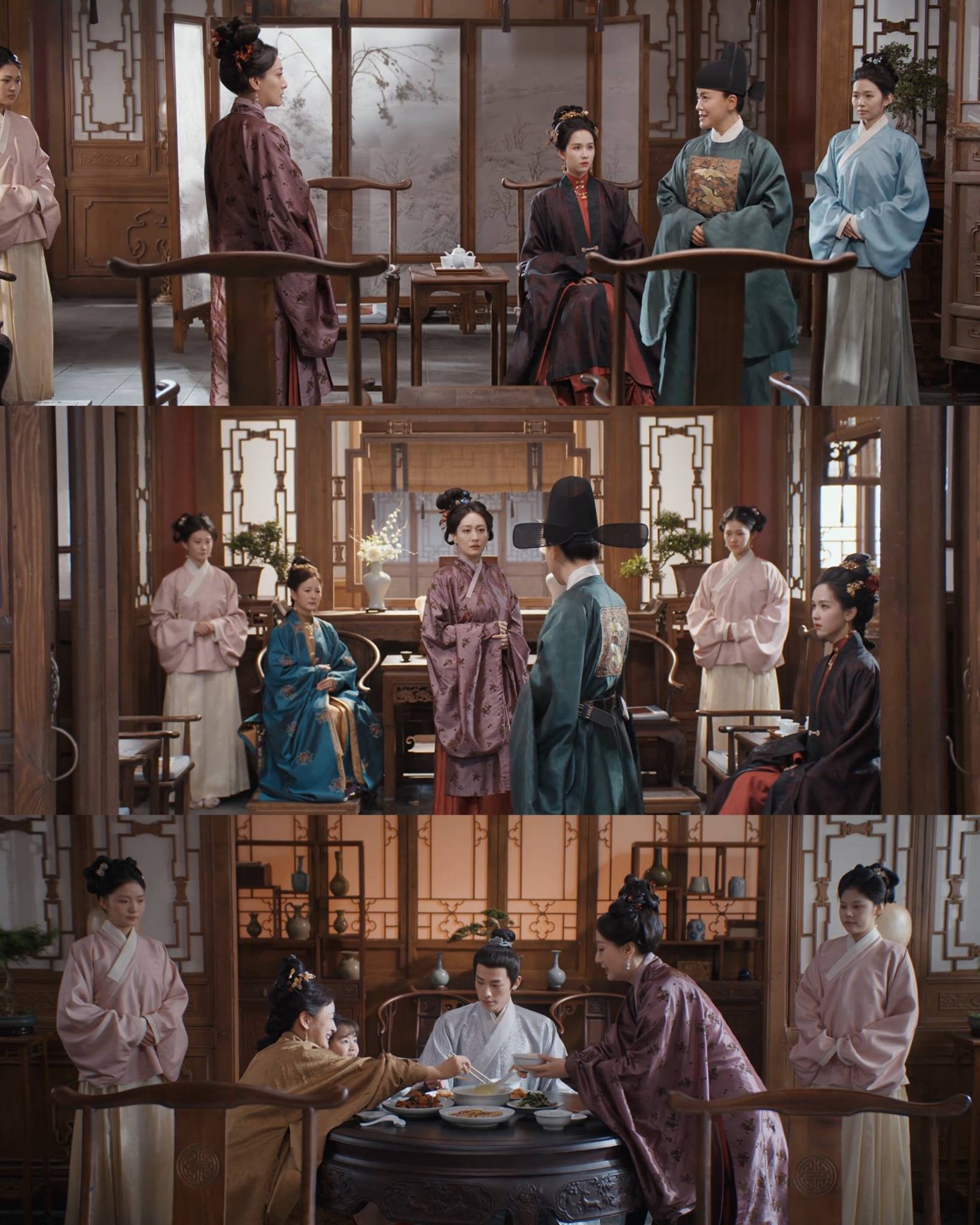
“The Ming-style furniture props were crafted based on historical texts and references to faithfully recreate tables and chairs, beds and couches, tea sets, tableware — even the food itself,” says production designer Wang Yifan.
Often hailed as the golden age of Chinese furniture, the Ming dynasty marked a turning point in design philosophy and craftsmanship. One of its most remarkable technical achievements was the refinement of intricate wood joinery techniques — such as mortise-and-tenon and tongue-and-groove — allowing pieces to be assembled like a puzzle without the use of glue, nails, or screws. These joinery techniques accommodate the natural expansion and contraction of wood, allowing wooden furniture to last for centuries.
Ming dynasty furniture embodies the marriage of form and function. Its aesthetic reflects Confucian ideals of balance, favoring restraint and moderation to achieve a sense of harmony and elegance in both design and spirit.
Ming-era guanmaoyi (官帽椅 guānmàoyǐ), meaning ‘official’s hat armchairs,’ elegantly frame numerous interior shots throughout ‘The Glory.’ Each component of this chair is aligned along a central axis, creating visual balance and drawing the eye to the chair’s clean lines and minimalist beauty.
This chair alone speaks to the lasting impact of Ming design, which extends beyond China. Its influences can be spotted in 20th-century European modernist design, most recognizably in the works of Danish designers such as Hans J. Wegner, with his China chair and Wishbone chair, and Arne Jacobsen, with his mid-1930s Bellevue chair.
Other notable characteristics of Ming dynasty furniture include the use of prized hardwoods like huanghuali rosewood (黄花梨 huánghuālǐ) and zitan red sandalwood (紫檀 zǐtán). Artisans adorned many pieces, including cabinets, tables, and folding screens, with inlays of mother-of-pearl, marble, coconut shell, lapis lazuli, and precious stones, while thoughtfully incorporating bamboo, rope, and rattan into seating and decorative details.
Decor
Gongshi: ‘Scholar’s Rocks’
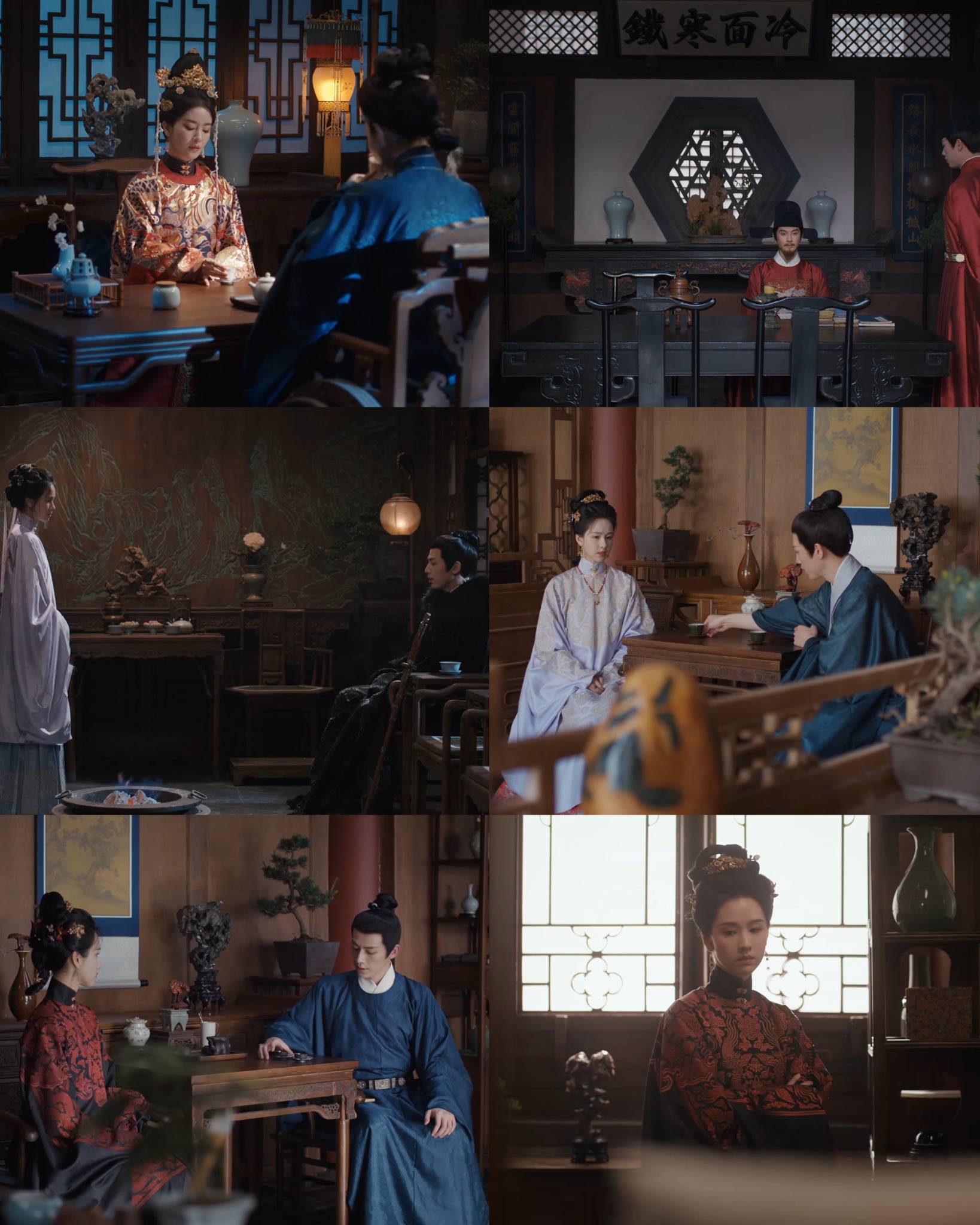
Gongshi (供石 gōngshí), also known as qishi gongshi (奇石供石 qíshí gōngshí), are naturally formed ornamental rocks or stones appreciated by scholars for their unusual shapes and qualities, which meet the poetic ideal of qishi (奇石 qíshí), meaning ‘strange and marvelous stones.’
The Ming dynasty saw a rise in scholarly appreciation for these abstract rocks or stones, which began in the Song dynasty with the expansion of the literati, as portrayed in the recent drama ‘Perfect Match.’
Gongshi are usually formed from karstic limestone. Prized stones are famously sourced from Lingbi in Anhui province, Taihu in Jiangsu province, and Yingde in Guangdong province.
Influenced by Daoist philosophy, scholars admired these rocks or stones for their unique shapes, colors, textures, the sound and resonance they produced when tapped, and their resemblance to mythical mountains where immortals are believed to dwell. They regarded these forms as the bones of the earth, a bridge to heaven, and a microcosm of the universe.
Gongshi are traditionally displayed on stands or trays, both indoors and outdoors. Placed on desks and tables in residences, set in courtyards, or nestled within the scenery of a classical garden, each one invites contemplation and meditation.
The art of appreciating and displaying gongshi would go on to inspire related traditions of stone appreciation in Korean and Japanese culture, known as suseok (수석) in Korean and suiseki (水石) in Japanese.
Teaware
Ming Dynasty Teapots and Tea Bowls
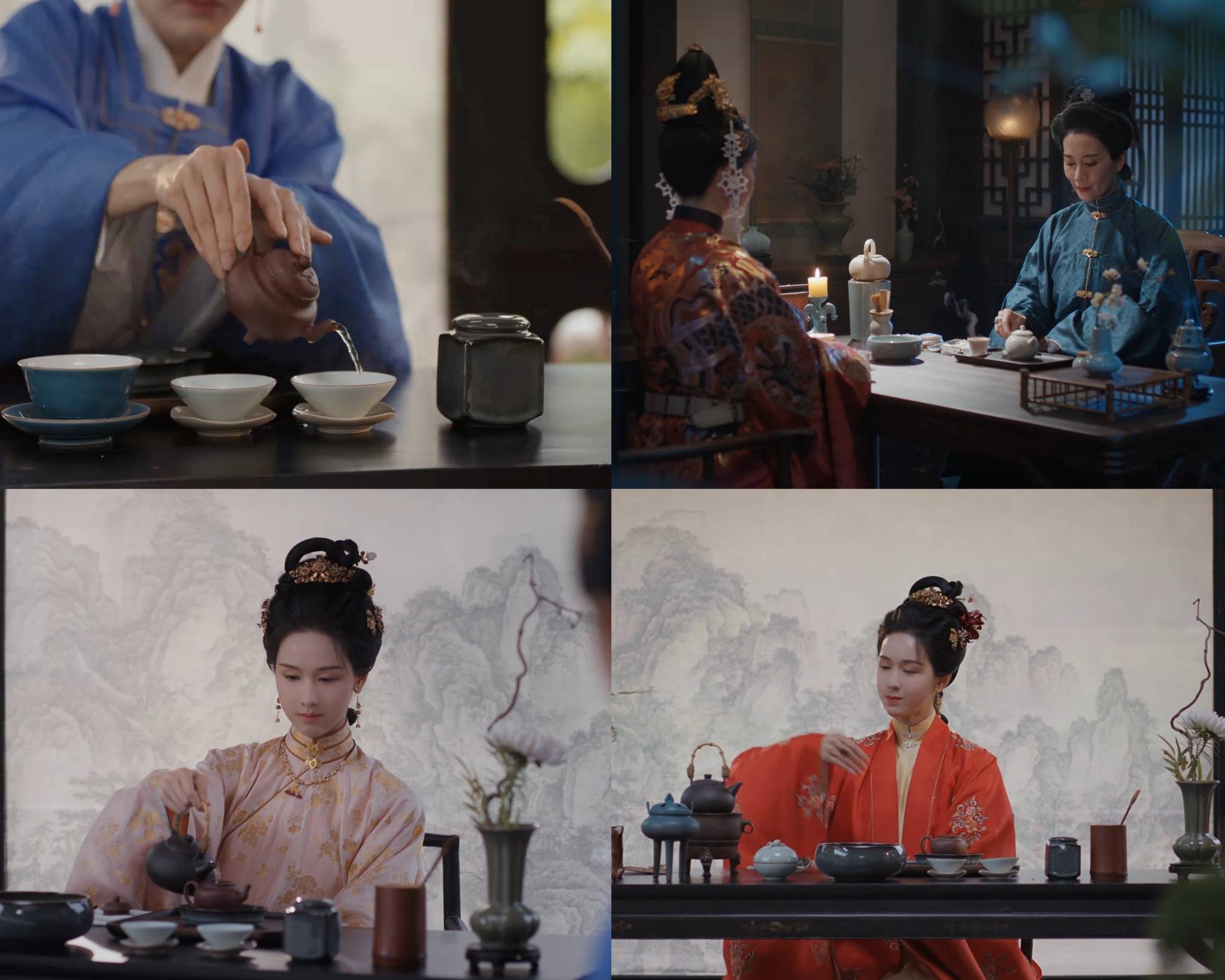
As Zhuang Hanyan’s mother, Ruan Xiwen (Wen Zhengrong), points out during a tea gathering, teaware pieces made from fine porcelain and clay were highly prized during the Ming dynasty.
When browsing tea shops today, we often hear of Jingdezhen porcelain and Yixing teapots. Blue-and-white porcelain from Jingdezhen in Jiangxi province and purple clay teapots from Yixing in Jiangsu province were finessed in the Ming era and highly valued for their appearance and ability to enhance the flavor of tea.
One of the most significant developments in Ming dynasty tea culture was the emergence of the small teapot, as steeping loose-leaf tea became the dominant method for preparing tea, replacing diancha (点茶 diǎnchá), the whisked powdered teas of the Song dynasty, and jiancha (煎茶 jiānchá), the ‘cooked’ teas of the Tang dynasty. With their compact design, these small teapots help preserve the fragrance of tea leaves and have since become synonymous with the Chinese gongfu tea ceremony.
The simplified brewing method of steeping loose-leaf tea led to a further reduction in the use of tea utensils during the Ming dynasty.
Meanwhile, refinements were made to the Chinese ‘tea bowl’ known as chazhan (茶盏 cházhǎn). The gaiwan (盖碗 gàiwǎn), a ‘lidded tea bowl’ for brewing and drinking loose-leaf tea, was also developed during the Ming era.


